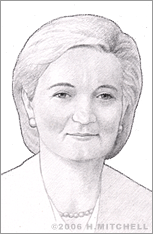Gail Naughton
The field of tissue engineering has transformed many areas of medicine, particularly reconstructive surgery and burn treatment, since it began in the early 1980s. Techniques developed by this field’s early pioneers, such as Gail K. Naughton, have made incredible procedures possible that earlier generations could have barely foreseen. As a result, thousands of patients worldwide now have less painful, more powerful treatment options for a range of afflictions from heart disease to diabetes to severe burns and torn ligaments.
New York native Naughton earned a BS in biology in 1976 from St. Francis College in Brooklyn. She went on to earn an MS degree in Histology from New York University (NYU) Medical Center in 1978 and a PhD in Hematology in 1981. While at NYU Medical Center, Naughton also served as an assistant professor of research, an instructor with the department of biology, and, from 1977 to 1981, as a supervisor in the clinical immunofluorescence lab. She also served as an assistant professor with the department of biology at Queensborough Community College, part of the City University of New York (CUNY), from 1985 to 1987. She held the post of visiting professor with the Department of Pediatric Hematology at Mt. Sinai Medical Center in New York from 1987 to 1989.
While pursuing post-doctoral studies in the Department of Dermatology at NYU Medical Center, Naughton made her first in what would become a long list of significant discoveries. At that time, around 1980, scientists who wished to grow cells in a lab for experimentation grew them in a growth medium on a flat surface, such as in a Petri dish. However, while she was involved in a study to observe the effects of certain drugs on tumors, it became clear to Naughton that the cells behaved differently in this environment than they would behave in their typical environment inside the human body.
She began working on a three-dimensional framework that would mimic the real-life conditions of cells as they grew inside the human body. The framework could be manipulated to simulate a variety of conditions and types of cells. It also used bioreactors to “trick” cells into responding as if they were actually inside the body. Growing tissue was pulled and stretched in the way that it would be if it were inside a human being so that proteins could be secreted to make sections of the tissue stronger, the way a heart valve is stressed inside a human heart or a ligament is pulled inside a foot or hand.
Naughton’s technique proved successful and was able to generate complex tissues that were virtually indistinguishable from those found in nature. However, at the time of her discovery, little work had been done in this area, and many of her ideas were met with skepticism. As a result, she became skillful at presenting her research in a way that would garner further funding and support. This helped her develop entrepreneurial skills that would later land her in a variety of executive roles with major biotechnology companies, including her own.
In 1986, she co-founded Advanced Tissue Sciences in New York. She later moved the company to La Jolla, California to take advantage of the biotech community that was beginning to develop in and around San Diego. The company went public in 1988, and Naughton received a patent for her matrix technology in 1990. She has held a variety of posts with the Advanced Tissue Sciences, such as executive vice president and COO (1991-1995), president and COO (1995-2000), and president (2000-2002). In 2002, she was named vice chairman of the board of directors.
Meanwhile, Naughton developed a variety of other novel treatments and tissue engineering processes. Of particular note, through a joint venture with Smith & Nephew, Advanced Tissue Sciences brought several successful skin grafting products to market.
The firm’s Transcyte product, for instance, was used to treat second- and third-degree burn patients. The temporary synthetic skin product covers wounds more effectively than other dressings with a low rate of rejection by the human body. It may be used to cover burn wounds while a patient’s body recovers enough to begin regenerating new skin on its own. A second product, Dermagraft, is used to repair skin wounds as well, but it grafts itself to the patient’s own tissue and becomes part of the person’s body. It is used extensively to treat patients with diabetic foot ulcers.
Naughton’s work has formed the basis for a wide and growing range of treatments and studies for nerve regeneration, periodontal surgery, bone healing, cartilage repair, anti-aging cosmetics, liver and other organ constructs, and more. Her numerous honors and awards for this work include the 2000 Intellectual Property Owner's Association's National Inventor of the Year Award and the 2002 Lindbergh-Carrel Prize from the Charles and Anne Lindbergh Foundation and the Alexis Carrel Foundation.
In 2001, Naughton completed an executive MBA in Executive Management from the Anderson School at the University of California, Los Angeles. She served as the Dean of the College of Business Administration at San Diego State University from 2002-2011.
Naughton is currently the founder, Chief Scientific Officer and Chief Business Development Officer of the regenerative medicine company, Histogen, Inc. She is a member of numerous academic and industrial boards and professional organizations. She holds more than 105 U.S. and foreign patents and has authored over 160 publications in the course of her career.


